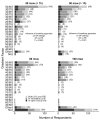Diving practices in technical divers' community and behaviour towards self-reported unusual symptoms
- PMID: 40544139
- PMCID: PMC12267066
- DOI: 10.28920/dhm55.2.114-125
Diving practices in technical divers' community and behaviour towards self-reported unusual symptoms
Abstract
Introduction: The use of gas mixtures containing helium for deep recreational diving is increasingly common, involving complex logistics and decision-making compromises. The characteristics and inherent risks of this practice remain poorly documented. This study aims to provide an epidemiological inventory of practices and diving-related incidents within the technical diving community.
Methods: An international online survey was disseminated on social networks targeting certified trimix divers. It collected demographic data, diving experience, and dive management practices, along with self-reported unusual symptoms, treatments, and outcomes following trimix dives.
Results: A total of 558 questionnaires were analysed, predominantly from males (92%), mostly over 46 years old (61%), with high certification levels and recreational diving purposes. Forty-two percent reported one or more medical risk factors related to diving. Rebreather use was prevalent (79% at least occasionally). Decompression was primarily managed using compartmental models (85%) with gradient-factors adjustment. Dive planning varied significantly among individuals. Gas density at depth frequently exceeded the current recommendations. Ten percent had experienced symptoms suggestive of gas toxicity, mainly related to nitrogen narcosis. Thirty-six percent (199/558) reported experiencing, at least once, symptoms of diving-related incidents, with 61% (n = 121/199) expressing certainty. In 48% (120/261) of incidents involving decompression sickness (DCS) or breathing symptoms, no treatment was initiated. Among episodes involving DCS symptoms (n = 254), 42% received normobaric oxygen, and 23% sought medical advice, while 16% were treated with hyperbaric oxygen. Only 2.5% reported probable long-lasting sequelae.
Conclusions: The diversity of practices highlights the lack of robust scientific data supporting them. The accident rate in mixed-gas diving may be higher than in typical scuba air diving, though mostly of mild severity. Treatment appears to be neglected despite divers' high knowledge levels. Continued research into decompression and the physiological effects of these dives is essential, along with ongoing awareness and education efforts in diving first aid within this exposed community.
Keywords: Decompression illness; Diving incidents; Epidemiology; Health status; Helium; Mixed gas; Survey.
Copyright: This article is the copyright of the authors who grant Diving and Hyperbaric Medicine a non-exclusive licence to publish the article in electronic and other forms.
Conflict of interest statement
No conflicts of interest were declared.
Figures


Similar articles
-
Extremely deep bounce dives: planning and physiological challenges based on the experiences of a sample of French-speaking technical divers.Diving Hyperb Med. 2025 Jun 30;55(2):203-210. doi: 10.28920/dhm55.2.203-210. Diving Hyperb Med. 2025. PMID: 40544151 Free PMC article.
-
Modelling the risk factors for accidents in recreational divers: results from a cross-sectional evaluation in Belgium.Diving Hyperb Med. 2024 Dec 20;54(4):287-295. doi: 10.28920/dhm54.4.287-295. Diving Hyperb Med. 2024. PMID: 39675736
-
Oxygen treatment and retrieval pathways of divers with diving-related conditions in Townsville, Australia: a 15-year retrospective review.Diving Hyperb Med. 2025 Jun 30;55(2):79-90. doi: 10.28920/dhm55.2.79-90. Diving Hyperb Med. 2025. PMID: 40544136
-
Home treatment for mental health problems: a systematic review.Health Technol Assess. 2001;5(15):1-139. doi: 10.3310/hta5150. Health Technol Assess. 2001. PMID: 11532236
-
Systemic pharmacological treatments for chronic plaque psoriasis: a network meta-analysis.Cochrane Database Syst Rev. 2021 Apr 19;4(4):CD011535. doi: 10.1002/14651858.CD011535.pub4. Cochrane Database Syst Rev. 2021. Update in: Cochrane Database Syst Rev. 2022 May 23;5:CD011535. doi: 10.1002/14651858.CD011535.pub5. PMID: 33871055 Free PMC article. Updated.
References
-
- Mitchell SJ, Doolette DJ. Recreational technical diving part 1: an introduction to technical diving methods and activities. Diving Hyperb Med. 2013; 43: 86–93. [cited 2024 Nov 1]. Available from: https://dhmjournal.com/images/IndividArticles/43June/Mitchell_dhm.43.3.8... - PubMed
-
- Rebreather Education and Safety Association (RESA). RESA standards v2.0; 2018. [cited 2024 Oct 31]. Available from: https://www.rebreather.org/wp-content/uploads/2018/12/RESA-_V2.0.pdf.
-
- Rebreather Training Council. RTC standard technical rebreather diver level three; 2018. [cited 2024 Oct 31]. Available from: http://rebreathertrainingcouncil.org/wp-content/uploads/2018/11/RTC-Tech...
-
- Fock A. Health status and diving practices of a technical diving expedition. Diving Hyperb Med. 2006; 36: 179–85. [cited 2024 Nov 1]. Available from: https://dhmjournal.com/images/IndividArticles/36Dec/Fock_dhm.36.4.179-18...
-
- Doolette DJ, Mitchell SJ. Recreational technical diving part 2: decompression from deep technical dives. Diving Hyperb Med. 2013; 43: 96–104. [cited 2024 Nov 1]. Available from: https://dhmjournal.com/images/IndividArticles/43June/Doolette_dhm.43.3.9... - PubMed
MeSH terms
Substances
LinkOut - more resources
Full Text Sources
